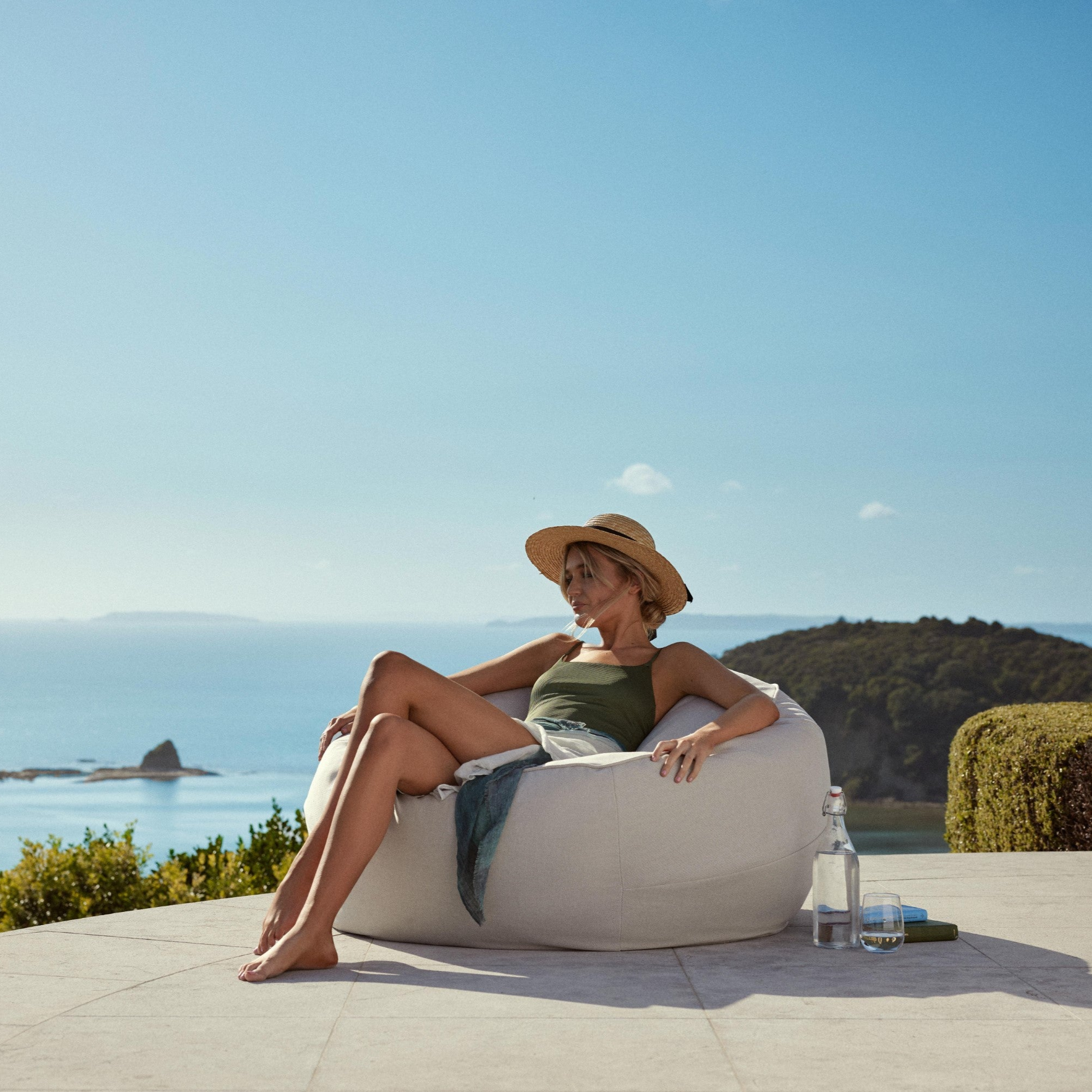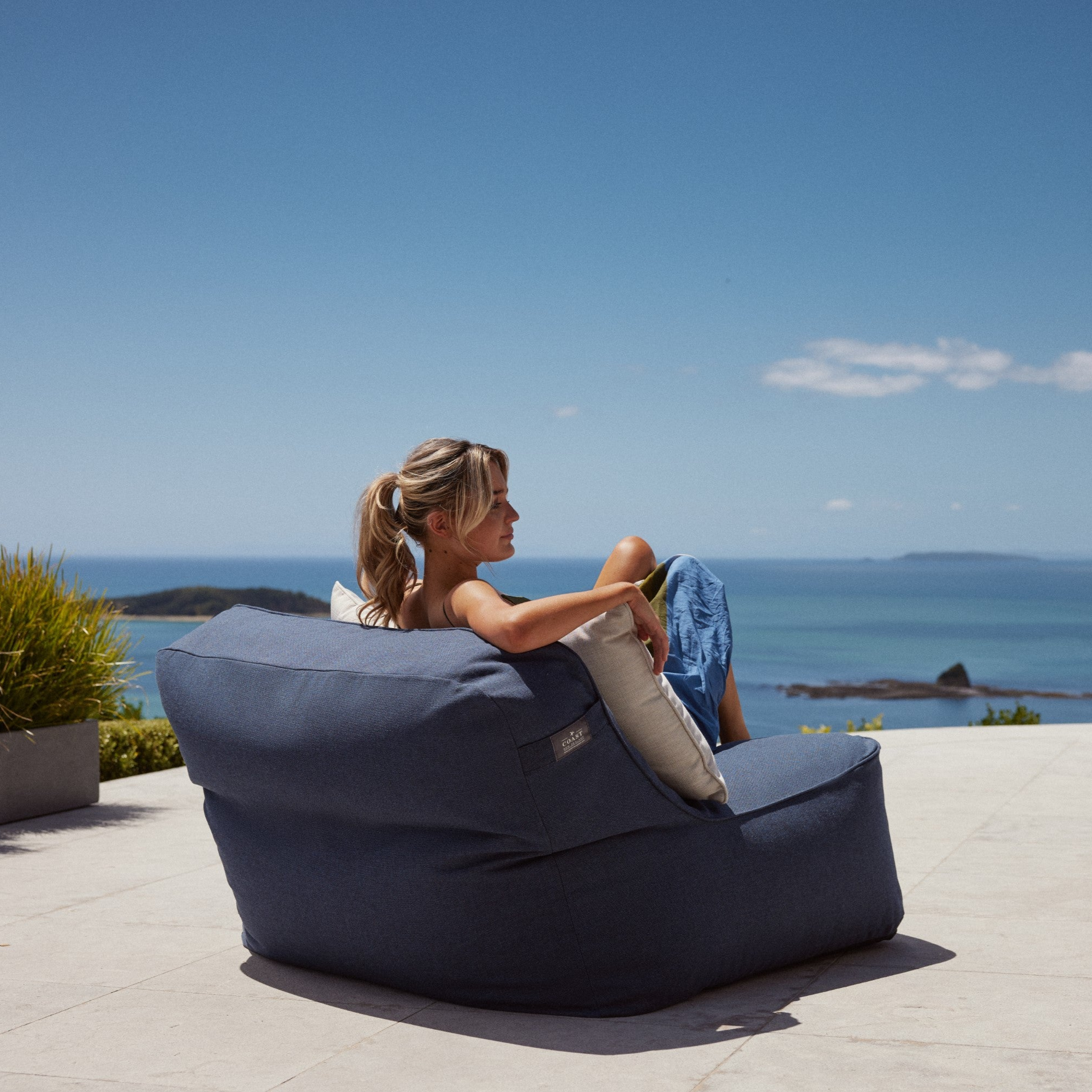Product Care
Coast outdoor beanbags and accessories are designed to survive outside, but in all cases, the life of your purchase will be greatly prolonged with regular cleaning and light maintenance - and a little common sense. In short, the better you treat it, the longer it will last!
Sunbrella® Fabric
Sunbrella is a solution-dyed acrylic specifically developed of exterior use. Sunbrella fabrics are highly water repellent, but breathable. Solution-dyed fibres are highly resistant to fading. Sunbrella’s unique colouring process avoids harmful effluents associated with conventional dyeing processes. It also dramatically reduces water and energy consumption.
Sunbrella fabrics are engineered for a serviceable lifespan two to ten times longer than conventional fabrics. The impact of producing cotton canvas, for example, must be multiplied many times to compare it with Sunbrella's extended longevity.
Sunbrella® Care Instructions
One of the best ways to keep Sunbrella® brand fabrics looking good and to delay deep or vigorous cleanings is to properly maintain the fabrics. This can be accomplished by simply brushing off dirt before it becomes embedded in the fabrics, wiping up spills as soon as they occur or spot cleaning soon after stains occur.
Keep beanbags clean and free from debris (such as falling leaves)– in most cases you will need little more than a brush, a damp cloth and/or a hose;
- Wipe up spills as soon as they occur;
- After heavy or prolonged rain, allow covers to air dry;
- Covers can be removed for machine washing. After washing, the covers should be re- sprayed with 303 Fabric - Guard;
- If possible, keep beanbags under cover if they are to be unused for any length of time (e.g. over the winter);
General or Light Cleaning
- Brush off any loose dirt.
- Prepare a cleaning solution of 1/4 cup/60ml mild soap per gallon/4 litres of lukewarm water (less than 100°F/38°C).
- Use a sponge or a soft bristle brush to clean.
- Allow cleaning solution to soak into fabric.
- Rinse thoroughly to remove all soap residue.
- Allow fabric to air dry.
Spot Cleaning
- Apply a light mist of our recommended cleaning solution using a spray bottle.
- Work the solution into the stain by lightly scrubbing the area with a sponge or very soft bristle brush.
- Rinse thoroughly to remove all soap residue.
- Blot excess moisture with a clean, soft towel or sponge.
- Wet-vacuum or blot excess water.
- Repeat these steps until stain is removed.
Salt Water
Salt water and sea-spray will not damage our beanbags. However, prolonged immersion in salt water will damage the metallic zip sliders and may ultimately compromise the fabric.
It is essential to rinse off salt water to avoid accelerated deterioration.
Heavy Cleaning for Stubborn Stains and Mildew
Sunbrella® fabric does not promote mildew growth, however, mildew may grow on dirt and other foreign substances that are not removed from the fabric. To clean mildew, or other stubborn stains:
- Prepare a solution of 1 cup/225 ml of bleach and 1/4 cup/60ml of mild soap per gallon/4 litres of clean water;
- Spray on entire area and allow to soak into the fabric;
- Scrub vigorously with a soft bristle brush, sponge, or clean towel;
- Rinse thoroughly to remove all soap residue;
- Allow fabric to air dry;
If stain and/or mildew are severe, bleach quantities may be increased.
For recommended cleaning methods of common stains download Sunbrella® Stain Chart PDF
Machine Washing
Remove covers and wash in cold water (less than 100°F/38°C). Depending on wash load size, use normal amounts of mild laundry soap and add 1 cup/225 ml of bleach. Allow fabric to air dry.
Re-Treating the Fabric for Ease of Cleaning
Sunbrella fabrics have a special finish that enhances water repellency. The finish is designed to last for several years of normal use, but may be refreshed after a thorough cleaning or extended use. We recommend 303 High Tech Fabric Guard™ as the preferred re-treatment product for Sunbrella fabrics.
Applying 303 High Tech Fabric Guard
303 should be applied to Sunbrella fabrics after each thorough cleaning, which typically removes the original finish and reduces the fabric’s water repellency.
- Clean Sunbrella fabric, using one of the cleaning methods;
- Allow Sunbrella to completely air dry;
- Apply 303 Fabric Guard in a well-ventilated area following instructions on the container;
- Apply 303 in a thin, even coat and allow fabric to dry completely;
- Apply a second thin, even coating of 303. (Two light coatings are more effective in restoring fabric water resistance than a single heavy coating;
A 32-oz/946 ml bottle provides coverage of up to 100 square feet of fabric.) Buy here
For more information, please visit www.303products.com.
DO NOT Dry Clean Sunbrella Fabrics.
Remove covers and wash in cold water (less than 100°F/38°C). Depending on wash load size, use normal amounts of mild laundry soap and add 1 cup/225 ml of bleach. Allow fabric to air dry.
Helpful Hints
Protect the area around your Sunbrella fabric when using a bleach solution – bleach may discolor non-Sunbrella fabrics. Always rinse Sunbrella thoroughly to completely remove bleach.
Sunbrella air-dries very quickly. Machine drying is not necessary and not recommended. If fabric has some wrinkling, use an iron, if necessary, but only on the synthetic* setting. As some irons exceed the recommended 100°F/38°C temperature on the synthetic setting, test a small inconspicuous area before ironing entire piece.
DO NOT use a steamer or iron set to steam setting. * Synthetic fabric heat settings normally do not exceed 150°F/66°C.
Top up
Please note that most polystrene beans will compress over time and that you may need to top-up your beanbag from time to time. See filling instructions or come to our Showroom where we can do it for you.
REPAIRS AND REPLACEMENTS
In the case of any damage or deterioration covered by our exterior guarantee or manufacturer's warranty, we will repair or replace the product free of charge.
In all other cases, we are always happy to assess the damage and quote for repairs or replacement, as the case may be. In most cases, we will ask you to return the relevant product, washed, for inspection and assessment. Most repairs can be completed quickly and at a very reasonable cost (and in many cases, free of charge).

